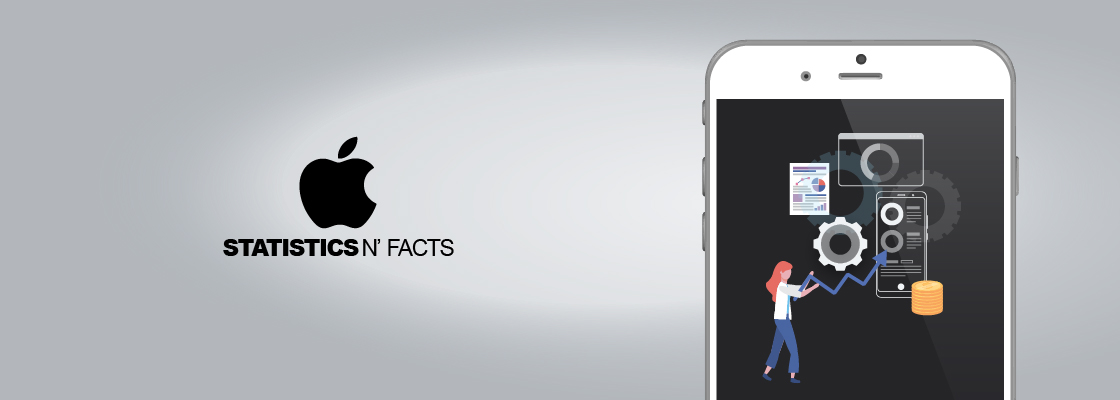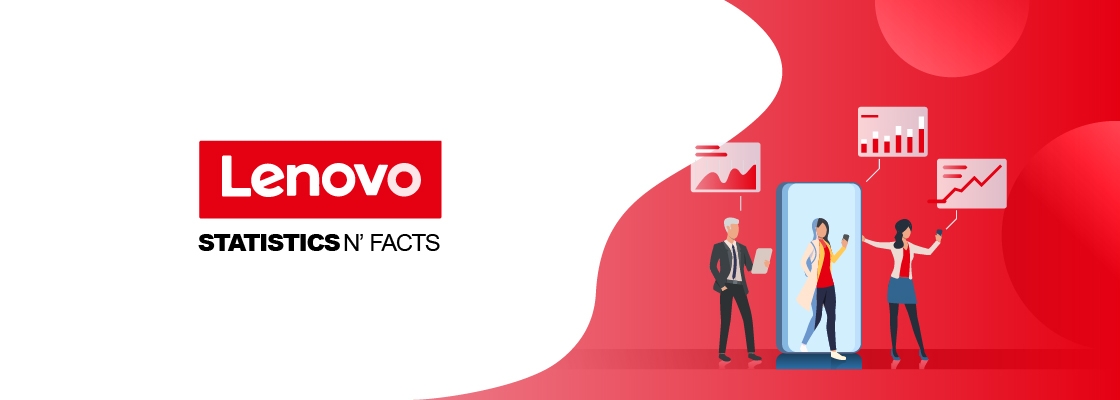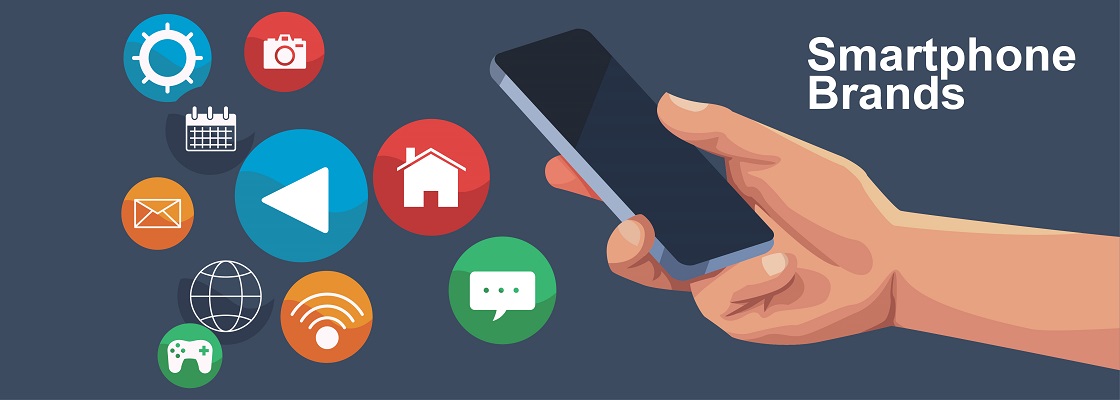Apple Statistics: Apple Inc. is engaged in designing, manufacturing, and marketing mobile communication, media devices, and personal computers. The company’s products and services include HomePod, iPad, iPhone, Mac, AirPods, Apple Watch, Apple TV, a wide portfolio of professional and consumer software applications, including macOS, iOS, tvOS, and watchOS operating systems, Apple Pay, iCloud, and a variety of another service, accessory, and support offerings. The company sells and delivers digital content and applications through the App Store, iTunes Store, Mac App Store, Apple Music, and TV App Store. Apple company sells its products globally via its online stores, retail stores, direct sales force, and third-party cellular network carriers, retailers, wholesalers, and resellers.
The company owns approximately 16.5 million square feet and has leased 24.3 million square feet of building space in the US. In addition, the company owns approximately 7,376 acres of land, primarily in the US.
Subsidiaries
1. Jurisdiction of Incorporation Apple Computer Trading (Shanghai) Co., Ltd. – China
2. Apple Distribution International – Ireland
3. Apple Europe Limited – UK
4. Apple Japan, Inc. – Japan
5. Apple Operations –Ireland
6. Apple Operations Europe – Ireland
7. Apple Operations International – Ireland
8. Apple Sales International – Ireland
9. Braeburn Capital, Inc. – Nevada, US
History
1 April 1976 – Apple Computers, Inc. was founded, and the first product was Apple I personal computer.
June 1977 – Apple II was launched.
December 1980 – The company conducted its first initial public offering (IPO) of 4.6 million shares at US$ 22 per share.
January 1983 – Apple launched the Lisa, which is a new brand of the personal computer.
December 1996 – Apple buys Jobs’ company – NeXT Software.
9 January 2001 – iTunes was introduced.
23 October 2001 – The iPod MP3 player was launched.
January 2003 – Apple releases the Safari – web browser.
28 April 2003 – Apple announced the launch of the iTunes music store.
January 2006 – Launch of company’s first Intel-based computers namely: the iMac and MacBook Pro.
9 January 2007 – iPhone launched.
March 2007 – Apple TV hits stores.
27 January 2010 – iPad was introduced.
6 June 2011 – Online media storage system – iCloud – launched.
6 February 2013 – Apple announces iTunes touched a milestone of around 25 billion songs sold.
28 May 2014 – Apple announces the purchase of Beats for around US$ 3 Billion.
9 September 2014 – Company launches wearable watch device – Apple Watch.
8 June 2015 – Company launches Apple Music –streaming music, social network, and live radio station.
12 September 2017 – Apple launches the iPhone X, along with iPhone 8 and iPhone 8 Plus – all of which support wireless charging.
On 14 February 2019, Apple acquires a UK-based DataTiger company – for its digital marketing technology.
2 August 2018 – Apple becomes the first American public company to surpass US$ 1 trillion in value.
August 2018 – Apple purchases US-based Akonia Holographics LLC – for the development of augmented reality goggle lens.
14 February 2019 – Apple acquires UK-based DataTiger company – for its digital marketing technology.
January 2020 – Apple acquired Xnor.ai, a US-based artificial intelligence software start-up.
March 2020 – Apple acquired Dark Sky, a weather application.
In March 2020 – Launched the new iPad Pro 2020 with the A12Z Bionic chip and Magic Keyboard with the trackpad.
March 2020 – Apple announced to introduce iPad Pro with a breakthrough LiDAR Scanner.
April 2020 – Apple introduced the new iPhone SE, a lower-cost model into the market.
April 2020 – Apple acquired Voysis Ltd, a developer of voice artificial intelligence platform.
May 2020 – Apple acquired NextVR, a provider of sports and other content for virtual-reality headsets.
June 2020 – At the first-ever virtual WWDC, CEO Tim Cook announced the transition from Intel processors to Apple silicon in Macs.
September 2020 – The iPhone 12, 12 Pro, and 12 Pro Max were introduced, being the first iPhones to support 5G.
November 2020 – The first Macs with Apple silicon were launched. The Mac mini, MacBook Air, and MacBook Pro all featured Apple’s M1 chip, itself based on the previous A14 Bionic chip.
In April 2021 – The M1-powered iPad was launched, along with a new M1-powered iMac offered in 7 colors, recalling the 1st generation: Tray-loading|iMacs offered in 5 colors announced in 1999. Apple also launched an iPhone 12 in purple and a GPS tracking device called AirTag that uses Apple’s Find My device network.
Business Strategy
The company is committed to bringing the best user experience to its customers through innovation in hardware, software, and services. The company’s business strategy is its unique ability to design, develop, and implement its own operating systems, software, hardware, and services in order to offer its customers products and solutions with innovative design, seamless integration, and superior ease of use. The company expands its platform for the discovery and delivery of digital content and applications via its Digital Content and Services, which allows customers to discover, download, or stream digital content from Apple TV and Mac or Windows personal computers. In addition, the company supports a community for the development of third-party software and hardware products as well as digital content that complements the company’s product offerings. The company focuses on building and expanding its own retail, online stores, and third-party distribution network, to effectively reach more customers and offer them a high-quality sales and post-sales support experience globally.
Business Organization
The company’s reportable segments are the Americas, Europe, Greater China, and the Rest of Asia Pacific.
| The Americas | Europe | Greater China | Rest of Asia Pacific |
|---|---|---|---|
| North America | European countries | China | Australia |
| South America | India | Hong Kong | Others |
| Middle East & Africa | Taiwan | Japan |
Products
- iPhone: It is a smartphone that is based on the iOS operating system. iPhone includes Siri, Touch ID, Apple Pay, and Face ID on qualifying devices.
- In October 2020, the company launched new iPhones namely: the iPhone 12,12 mini, 12 Pro, and iPhone 12 Pro Max with 5G technology.
- iPad: This is a multi-purpose tablet based on its iOS operating system, including iPad Pro, iPad, and iPad mini.
- In October 2020, the company launched a new version of iPad Air with an advanced A14 Bionic chip available to order starting today.
- Mac: The company’s product line of desktop and portable personal computers is based on its macOS operating system. The desktop computers include iMac 21.5-inch, iMac Pro, iMac 27-inch, with Retina 5K display, iMac 21.5-inch with Retina 4K display, Mac mini, and Mac Pro.
- In October 2018, the company launched a new MacBook Air featuring a Retina display and Touch ID, and a new Mac mini with upgraded performance
- Other Products: Includes accessories such as beats products, headphones, displays, storage, devices, and various other connectivity and computing products, including Apple TV, Apple Watch, and iPod touch.
- In October 2020, the company launched the HomePod mini, a smart speaker.
- In June 2017, the company launched the HomePod wireless speaker.
- In September 2017, the company announced the launch of AirPower, which is a new wireless charging accessory.
- In September 2017, the company introduced Apple Watch Series 3, featuring fitness and health enhancements and built-in cellular capability on qualifying devices.
- In September 2017, the company introduced Apple TV 4K, which supports 4K and High Dynamic Range content, providing customers with enhanced picture quality.
Operating Systems
- iOS: A mobile operating system that serves iOS devices.
- In October 2020, the company launched iOS 14, which includes new capabilities to improve images in photos and camera, and enhanced Siri functionality and iPad features.
- macOS: Is an operating system that is built on an open-source UNIX-based and offers an intuitive and integrated computer experience to customers.
- In September 2017, the company launched macOS and incorporates new storage, video, and graphics technologies in order to improve photos, mail, and Safari.
- watchOS: The operating system for the Apple Watch product.
- In September 2020, the company launched Apple Watch SE, which adds a proactive Siri watch face that shows the user’s most needed information throughout the day, offers a new music experience, and personalized activity coaching.
- tvOS: An operating system – Apple TV, which is based on the iOS platform and supports developers to create new games and apps for Apple TV and deliver them to customers via the Apple TV App Store.
Services
- Digital Content and Services
- The iTunes Store – available for Mac, iOS devices, and Windows personal computers
- Apple TV – allows customers to purchase, download, and stream TV shows or movies
- The App Store – available for iOS devices, which allows customers to discover and download apps and purchase in-app content
- The Mac App Store – available only for Mac computers that allow customers to discover, download, and install various Mac applications
- The TV App Store – permits customers to access games and apps for Apple TV
- The iBooks Store – available for a wide range of iOS-supported devices and Mac computers for reading e-books from independent and major publishers globally
- Apple Music – offers users an unlimited listening experience with on-demand radio stations which can be played or downloaded
- iCloud – is a service that stores photos, stores music, contacts, mail, documents, and calendars. It is available across a wide range of devices, including iOS devices, Apple TV, and Mac or Windows personal computers. iCloud services include iCloud Drive, Find My iPhone, iCloud Keychain, Family Sharing, iPad or Mac, iCloud Photo Library, Notes, Find My Friends, and iCloud Backup for iOS supporting devices.
- AppleCare: offers a wide range of options for customers, including assistance for software products, online support, the AppleCare Protection Plan (APP), AppleCare+ (AC+), electronic product manuals, and technical assistance
- Apple Pay: is a cashless payment service available in some countries, and is an easy, secure, and private solution for payment. Apple Pay allows users to pay for purchases in stores accepting contactless payments mode. The Apple Pay service accepts all types of debit and credit cards across major card networks.
Markets and Distribution
The company primarily caters to consumers of small and mid-sized businesses, education, enterprise, and government. The company sells its products through indirect distribution channels such as wholesalers, third-party cellular network carriers, resellers, and retailers as well as direct distribution channels.
- In 2018, the company’s registered net sales through its indirect and direct distribution channels accounted for 71% and 29% respectively of total net sales
Financial Highlights
- The company’s overall revenue decreased from US$ 246,736 Million in 2020 to US$ 259,034 Million in 2019.
- During 2019, the company’s net sales through its direct and indirect distribution channels accounted for 31% and 69%, respectively, of total net sales.
- Net Sales by Product: 2020
- iPhone product sales decreased by -3%
- iPad product sales increased by 11%
- Mac product sales increased by 11%
- Services sales increased by 16%
- Other products increased by 25%
- Net Sales by Reportable Segment: 2020
- Americas segment sales increased by 7%
- Europe segment sales increased by 14%
- Greater China segment sales decreased by -8%
- The rest of the Asia Pacific segment sales increased by 10%
- Gross margin increased to US$ 104,956 in 2020, from US$ 98,392 in 2019, primarily due to a favorable shift in the mix of iPhones with higher average selling prices and services net sales.
News Update: 2021
- Number of Active Apple Device Users: 1.65 Billion
- Number of Active Mac Users: 100 Million
- Apple’s Market Capitalization: US$ 2 .08 Trillion
- Average Number of Macs Sold per Minute: 31
- Number of TV Sold: 13 Million
- Number of Apple TV apps: 8,000 Apps
- Number of Apple TV apps that are Games: 2,000 Apps
- Number of iCloud Users: 850 Million
- Average Number of Requests Siri gets per Month: 25 Billion
- Number of Apple Stores worldwide: 525 stores
News Update: 2019
- In January 2019, the company announced plans to launch AirPods 2 with exciting new features in the first half of 2019.
- In January 2019, Apple announced plans to launch the iPad Mini 5 – new entry-level iPads in the first half of 2019.
- In February 2019, the company launched 16-inch MacBook Pro with a new design.
- In March 2019, the company launches iPad mini 5, 10.5-inch iPad Air, 4K, and 5K iMacs, AirPods 2, and Apple News+.
- May 2019 – Powerbeats Pro, and MacBook Pro launched.
- In September 2019, Apple was the leading tech giant in AI domination with 20 AI startups acquisition since 2010.
Products launched in 2021
- Apple product launch showcases new tags, Watch Series 6, slim iMacs, and more destined.
- In March 2020, Apple launched the new iPad Pro with the A12Z Bionic chip and Magic Keyboard with the trackpad.
- In April 2020, Apple introduced the new iPhone SE, a lower-cost model into the market.
- In June, the company launched an open-source project for password manager developers.
- In August, the company launched two new radio stations on Apple Music namely, Apple Music Hits and Apple Music Country, and also announced its flagship radio station, Beats 1, which has been renamed Apple Music 1.
Fun Fact
- The company name ‘Apple’ came from founder, Mr. Steve Jobs, which means like the fruit
- Apple was known as Apple Computer, Inc. during its first 30 years, and was renamed Apple Inc. on January 9, 2007. The word computer is removed to reflect its expanding electronics market.
- Apple.com is in the top 50 websites and in the top 30 in the US
- The first Apple computer did not have a keyboard or screen
- Apple Inc. is the largest technology company in the world and is the second-largest cell phone manufacturer next to Samsung.
- Apple has the highest market value of 961.3 billion US$ among the 100 largest companies in the world
- The brand value of Apple in 2020 is 352.206 Billion US$









